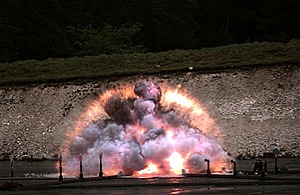"Take aim, press print."
A project at Dstl has created a new technique which could offer on-demand, 3D-printed explosives at the front line.

Explosion
Energetics experts are essential for defence and security; from forensic analysis to the protection of troops from explosive devices. Since recognising this national decline in the energetics sector, the MOD has since invested nearly £10 million, to combat the issue by establishing the Future Energetics Project in 2015. Subsequently, the Future Energetics Project has significantly invested in both people, technologies and equipment to develop this UK capability.
The Future Energetics Project has adopted an innovative research path, manned by early-career scientists and engineers, to explore the next ‘big things’ in energetics technologies. Graduates, Apprentices and more experienced staff on the project are heavily involved in research, explosives trials, novel energetics manufacture, blast modelling, chemical synthesis, thermal characterisation and small-scale hazard testing. This work has a direct impact on how the UK tackles ongoing threats, whilst rapidly building up experience in people for the future.
The Future Energetics Project has a number of aims including the development of new energetic materials, diagnostic methods to validate new materials and processing tasks with the benefit of sustaining the capability for the next generation. One of the most exciting developments is applying additive manufacturing – or 3D printing – to new explosive formulations.
3D printing explosives offers numerous benefits for potential users, including reducing storage and transport costs, and enhanced performance with reproducibility. Charges can be printed on demand, bespoke to requirements, in novel and intricate designs previously impossible to manufacture.
The energetic formulations for 3D printing are manufactured in a LabRAM resonant acoustic mixer, which uses acoustic energy rather than physical blades to mix materials, making it safer and more efficient to use. Many organisations are looking at different stages of 3D printing, but Dstl is the only place in the UK that is working on an end-to-end process of this kind with high explosives.
The 3D printing project is currently in testing stages, mainly focusing printer capabilities and material extrusion to then move on to examining explosive characteristics of a print including utilising charge geometry to create different explosive effects. Understanding what shape has what effect could lead to bespoke printing for individual missions in a warzone, providing an amplification of an effect with less material. As 3D printers give limitless possibilities, this is a real breakaway from traditional explosives.
A spokesperson from Dstl said:
“Without investment, the UK capability would die,”
“It’s up to MOD to make sure that doesn’t happen, as industry has limited or no capability in many critical areas.”
The funding – which has since grown, following early successes – has led to innovative research and has put the UK on track to ensure there are enough suitably qualified and experienced personnel across all areas.
The spokesperson said:
“Energetics knowledge and experience is vital for the UK to develop the best equipment, platforms and operational assets. We need to know how energetic systems damage or defeat our platforms and how we can counter threats, so we can advise on things like countermeasures, detection, safety, transportation and disposal, all while working with explosives in accordance with legislation.
“Having this capability also means we can rigorously test and evaluate vehicles and systems against current and emerging threats to ensure they offer the required protection for armed forces. We also need to be able to support the police and counter-terrorism units who deal with explosions and homemade devices, such as the Manchester bombing in 2017.”
The Future Energetics Project has attracted people from a range of backgrounds such as forensic science, mathematics, chemistry, physics, graphic design, engineering and astrophysics. The need to improve UK energetics capability has been recognised by a number of national and international partners, and many activities are now available to develop skills.
Dstl played a critical role in establishing both the Centre of Excellence in Energetic Materials (CoEEM), a virtual centre based at Cranfield University which co-ordinates research and training; and the Sector Skills Strategy Group (SSSG) within the Institute of Explosives Engineers, which provides strategic direction to sustain explosives skills.